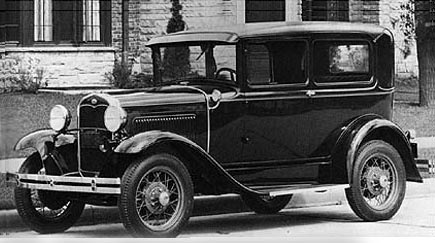 June 28, 2018 (Thursday)
June 28, 2018 (Thursday)
The Ford Model A was manufactured from 1927 through 1931. I was born in 1931. Consequently, the car many people were driving when I was a child was the Model A. Through the years, the Model A continued to be popular for collectors, and still appears in antique motor car shows.
When I was called to be the pastor at Oletha Baptist Church, I had to figure out a way to get back and forth from college at Waco, 50 miles away. I knew Dwight Dudley, who drove a Model A, and asked him if he would like to go with me to Oletha. I had a church but no car, and Dwight had a car but no church. He drove us back and forth on weekends for a number of weeks until I could arrange for transportation of my own. Dwight later became a missionary to Japan and Okinawa. Bill Webb, from Mississippi, joined us at the Oletha church; he led the singing, while Dwight taught the men’s Sunday School class. Bill later became a pastor in Kentucky, Ohio and Mississippi. He is now retired, and Dwight is with the Lord.
I’ve been thinking about the Model A driven by Dwight, and those I saw when I was a boy growing up. There were a lot of differences between modern cars and those early ones.

Early models had horns that were mounted near the driver’s window so that he could press the rubber bulb and make a sound. A little better type was the “ooga” that was produced by pushing a rod on the horn.
Headlights were considered extras and were always mounted in such a way that their locations resembled those of the lanterns they had replaced.
The term, “car pocket,” was a realistic description of a fabric opening, much like a coat pocket, in each door. The “glove box” would come along later.
A few days ago, I was a passenger in my granddaughter’s Chevrolet SUV, and her dashboard was a marvel of technology. A “TV Screen” showed a map and a voice told her where she was and how she could get to her destination. The gas tanks of modern cars are no longer right in front of the driver (horrors), but underneath and behind. Seat belts and air bags add needed safety for today’s high speeds and heavy traffic.
When I was still a pre-schooler, I would climb up into the family car in the driveway and observe these things, pretending to drive, but I did not have the strength to turn the steering wheel. The windshield was hinged at the top, and a little crank turned to move the bottom forward to allow air to flow into the passenger section. If it rained, there was a lever at the top of the windshield that the driver could manually turn back and forth to wipe the rain away. The roofs of most cars back then were made of canvass. A trunk was literally a removable piece of luggage attached to the rear of the car. Radios and heaters could be added but were cumbersome, and air conditioning was totally unknown. There were absolutely no adjustments for seating, etc.By 1937, you could buy a new car for $750 (equal to $13,380 in 2018).
Those, I suppose, were “the good old days.” But just thinking about how things used to be, it is understandable that some people are attracted to the “oldies but goodies” that are now very valuable antiques.


